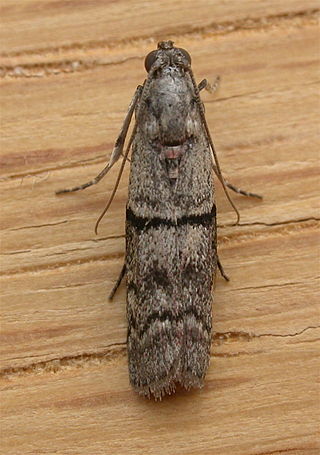
Crambinae is a large subfamily of the lepidopteran family Crambidae, the crambid snout moths. It currently includes over 1,800 species worldwide. The larvae are root feeders or stem borers, mostly on grasses. A few species are pests of sod grasses, maize, sugar cane, rice, and other Poaceae. The monophyly of this group is supported by the structure of the tympanal organs and the phallus attached medially to the juxta, as well as genetic analyses.

Diatraea is a genus of moths of the family Crambidae.

The Chrysauginae are a subfamily of snout moths. They are primarily Neotropical and include about 400 described species.

Homoeosoma is a genus of moths of the family Pyralidae.

Actrix nyssaecolella, the tupelo leaffolder moth, is a species of moth of the family Pyralidae described by Harrison Gray Dyar Jr. in 1904. It is found from Michigan and New York to Florida and west to Texas.
Adanarsa is a monotypic snout moth genus in the subfamily Phycitinae. It was described by Carl Heinrich in 1956. It contains the species Adanarsa intransitella, which was originally described as Rhodophaea intransitella by Harrison Gray Dyar Jr. in 1905. It is found in North America, including Arizona, New Mexico and California.
Anypsipyla is a monotypic snout moth genus described by Harrison Gray Dyar Jr. in 1914. Its only species, Anypsipyla univitella, was described by the same author in the same year. It is found in Central America, South America and has also been recorded from Cuba, Mexico, Jamaica and Florida in the southern United States.

Dioryctria is a genus of snout moths. It was described by Philipp Christoph Zeller in 1846.
Cassiana is a monotypic snout moth genus described by Carl Heinrich in 1956. Its only species, Cassiana malacella, was described by Harrison Gray Dyar Jr. in 1914. It is found in Mexico, the southern United States, the British Virgin Islands Puerto Rico and Bermuda.
Ceracanthia is a genus of snout moths. It was described by Émile Louis Ragonot in 1893.

The Phycitini are a tribe of moths of the family Pyralidae.
Actrix dissimulatrix is a species of snout moth in the genus Actrix. It was described by Carl Heinrich in 1956. It is found in North America, including the type location of Virginia.
Entmemacornis is a genus of snout moths. It was described by Harrison Gray Dyar Jr. in 1919.

Ephestiodes is a genus of snout moths. It was described by Émile Louis Ragonot in 1887.
Erelieva is a genus of snout moths. It was described by Carl Heinrich in 1956.
Eumysia is a genus of snout moths. It was described by Harrison Gray Dyar Jr. in 1925.
Baphala is a genus of snout moths. It was described by Carl Heinrich in 1956.

Sciota is a genus of snout moths. It was described by George Duryea Hulst in 1888.

Vitula is a genus of snout moths. It was described by Émile Louis Ragonot in 1887.
Olybria is a genus of snout moths erected by Carl Heinrich in 1956.








